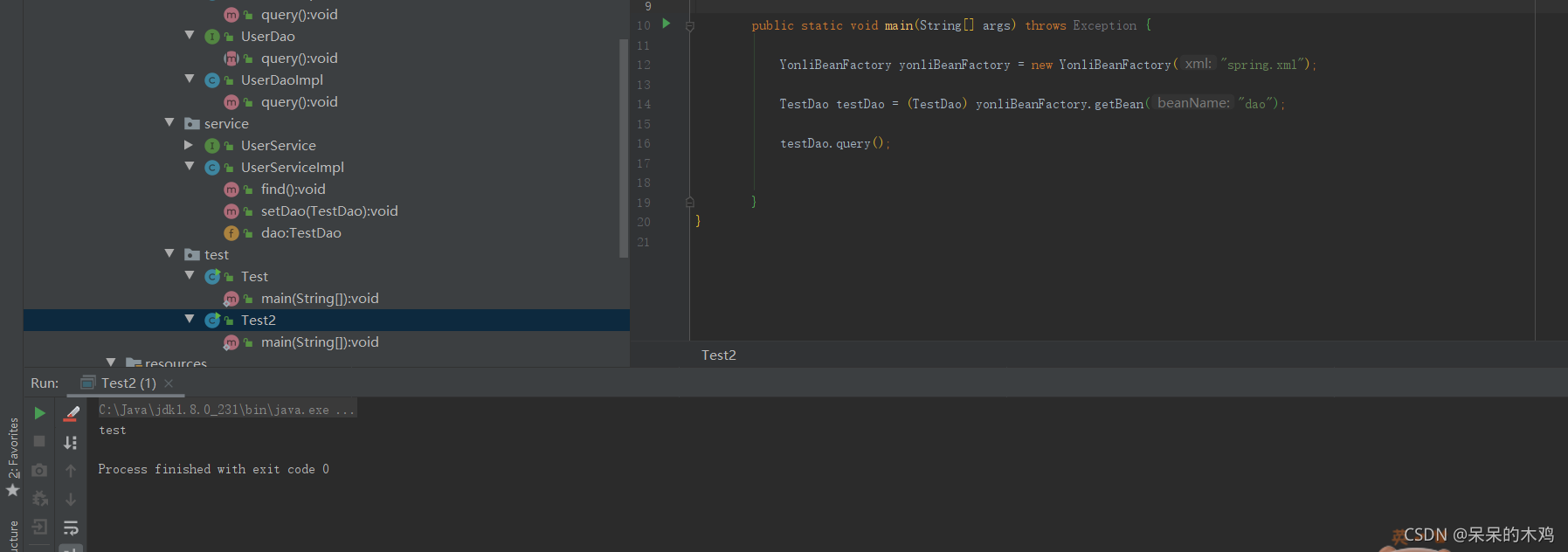Ioc是什么?
前提了解
IOC他获取到了对象他一定有一个地方去存储那个对象 beanName 和 Object 这样键值对存储 所以我们选择用map<String,Object>
来存储 ,我们这里解析xml使用的是dom4j 让我们一起了解如何解析xml和实例化吧
思路
通过解析xml拿到类的名字通过反射创建类 创建好类放入map中
主要类
import org.dom4j.Attribute;
import org.dom4j.Document;
import org.dom4j.DocumentException;
import org.dom4j.Element;
import org.dom4j.io.SAXReader;
import java.io.File;
import java.lang.reflect.Constructor;
import java.lang.reflect.Field;
import java.lang.reflect.InvocationTargetException;
import java.util.*;
/*
* 第二个版本 添加byTaype 和byNmae类型自动装配
* */
public class YonliBeanFactory {
Map<String,Object> map = new HashMap<String,Object>();
public YonliBeanFactory(String xml){
parseXml(xml);
}
private void parseXml(String xml) {
File file = new File(this.getClass().getResource("/").getPath()+"//"+xml); //获取xml路径
SAXReader reader = new SAXReader(); //dom4j 对象
try {
Document document = reader.read(file); //dom4j 读取xml 获取documen对象
Element elementRoot = document.getRootElement(); //得到最外面的标签 <beans>
Attribute aDefault= elementRoot.attribute("default");
boolean flag=false;
if (aDefault!=null){
flag=true;
}
for (Iterator<Element> itFirlst = elementRoot.elementIterator();itFirlst.hasNext();){ //便利beans下面的标签 <bean>
Object object = null;
Element elementFirstChil = itFirlst.next();
Attribute idAttribute = elementFirstChil.attribute("id"); //得到bean标签 的属性对象
Attribute classAttribute = elementFirstChil.attribute("class");
String idvalue = idAttribute.getValue(); //获取属性对象的值
String classValue = classAttribute.getValue();
Class clazz = Class.forName(classValue); //加载类
//新建 calss 加载的类
for (Iterator<Element> itSecond=elementFirstChil.elementIterator();itSecond.hasNext();){ //判断<bean> 下面是不是有子标签
Element itSecondChil = itSecond.next();
if (itSecondChil.getName().equals("property")){ //如果有子标签名字为 property 表示这是一个 注入属性
//通过set get 注入
object= clazz.newInstance();
String ref = itSecondChil.attributeValue("ref"); //获取注入属性值value
String name = itSecondChil.attributeValue("name"); //获取注入属性的名字
Object injetObject = map.get(ref); //获取之前注入的bean
Field field = clazz.getDeclaredField(name);
field.set(object,injetObject); //调用方法赋值 //反射复制
}else{
//证明有特殊构造器
String refVlaue = elementFirstChil.attribute("ref").getValue();
Object injetObject= map.get(refVlaue) ;
Class injectObjectClazz = injetObject.getClass();
Constructor constructor = clazz.getConstructor(injectObjectClazz.getInterfaces()[0]);
object = constructor.newInstance(injetObject);
};
}
if (object == null){//没有赋值证明没有子标签
if (flag){ //证明有这个标签
if (aDefault.getValue().equals("byType")){
Field fields[] = clazz.getDeclaredFields();
for (Field field: fields) {
//得到屬性的類型,比如String aa那麽這裏的field.getType()=String.class
Class injectObjectClazz = field.getType();
/**
* 由於是bytype 所以需要遍历map当中的所有对象
* 判断对象的类型是不是和这个injectObjectClazz相同
*/
int count = 0;
Object injectObject = null;
for (String key : map.keySet()) {
Class temp = map.get(key).getClass().getInterfaces()[0];
if (temp.getName().equals(injectObjectClazz.getName())) {
injectObject = map.get(key);
//记录找到一个,因为可能找到多个count
count++;
}
}
if (count > 1) {
throw new YongliSpringException("需要一个对象,但是找到了两个对象");
} else {
object = clazz.newInstance();
field.setAccessible(true);
field.set(object, injectObject);
}
}
}
if(aDefault.getValue().equals("byName")){ //装配是根据名字
object = clazz.newInstance();
Field fields[] = clazz.getDeclaredFields();
for (Field field: fields) {
String fieldName = field.getName();
for (String key : map.keySet()) {
if (key.equals(fieldName)){
field.set(object,map.get(key));
}
}
}
}
}
}
if(object==null){//沒有子標簽
object = clazz.newInstance();
}
map.put(idvalue,object); //将本次循环的object放到map中
}
} catch (DocumentException e) {
e.printStackTrace();
} catch (ClassNotFoundException e) {
e.printStackTrace();
} catch (NoSuchFieldException e) {
e.printStackTrace();
} catch (IllegalAccessException e) {
e.printStackTrace();
} catch (InstantiationException e) {
e.printStackTrace();
} catch (NoSuchMethodException e) {
e.printStackTrace();
} catch (InvocationTargetException e) {
e.printStackTrace();
}
}
public Object getBean(String beanName){
return map.get(beanName);
}
}
xml配置
<?xml version="1.0" encoding="UTF-8"?>
<!--
1、哪些类需要我来关联
2、怎么告诉我这些类(写bean)
3、怎么维护依赖关系(settr、constr)
4、怎么体现setter或者constr
-->
<beans default="byName">
<bean id="dao" class="com.yongli.dao.TestDaoImpl"></bean>
<bean id="service" class="com.yongli.service.UserServiceImpl">
</bean>
</beans>
xml需要注入的类
package com.yongli.dao;
public class TestDaoImpl implements TestDao {
public void query() {
System.out.println("test");
}
}
package com.yongli.service;
import com.yongli.dao.TestDao;
public class UserServiceImpl implements UserService {
public TestDao dao;
public void find() {
System.out.println("service");
dao.query();
}
public void setDao(TestDao dao) {
this.dao = dao;
}
}
测试类
public static void main(String[] args) throws Exception {
YonliBeanFactory yonliBeanFactory = new YonliBeanFactory("spring.xml");
TestDao testDao = (TestDao) yonliBeanFactory.getBean("dao");
testDao.query();
}
结果

基于注解注入
思路 通过传入的路径com.xx.xx 转化为路径 com\xx\xx 扫描 target 文件 来获得类的名字 通过反射拿到类对象 查看是否有指定的注解如果有 创建类实例 并且加入map
主要类
package com.org.springAnnotation;
import com.org.Yongli;
import java.io.File;
public class AnnotationConfigApplicationContext {
public void scan(String basePackage){
//获取这个类的路径
String rootPath = this.getClass().getResource("/").getPath();
//把得到的xx. 改成路径的 xxx/
String basePackagePath =basePackage.replaceAll("\\.","\\\\");
//
File file = new File(rootPath+"//"+basePackagePath);
//返回文件下的文件名字
String names[]=file.list();
for (String name : names) {
//移出.class 获取文件名字
name=name.replaceAll(".class","");
try {
//拼接加载创建出来class
Class clazz = Class.forName(basePackage+"."+name);
//判斷是否是屬於@servi@xxxx
if(clazz.isAnnotationPresent(Yongli.class)){
//这里本来是存到map里面 spirng里面是存到数据结构里面没有写了
Yongli yongli = (Yongli) clazz.getAnnotation(Yongli.class);
System.out.println(clazz.newInstance());
}
} catch (Exception e) {
//如果创建失败 到这里重新开始下一次循环
e.printStackTrace();
}
}
}
}
注解
package com.org;
import java.lang.annotation.Retention;
import java.lang.annotation.RetentionPolicy;
//注解生命周期
@Retention(RetentionPolicy.RUNTIME)
public @interface Yongli {
}
测试类
public static void main(String[]args){
AnnotationConfigApplicationContext annotationConfigApplicationContext = new AnnotationConfigApplicationContext();
annotationConfigApplicationContext.scan("com.yongli.dao");
}
结果图

结束语
spring基于xml 的是第二版增加了功能看起来不是那么容易 可以看第一版思路差不多 只是变了部分 注解版实在不想写了累了
源码地址 dome源码地址点击这里 有时候不知道为了什么去做这些只知道做下去迷茫~